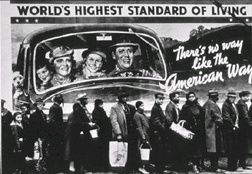"SIG Barofsky outlined the depletion of needed funds that failed loan modifications cause to already troubled families. With a rate of 100,000 bank repossessions a month, Barofsky notes, the stakes are high and the public harm is significant."
The Special Inspector General for the Troubled Asset Relief Program (SIGTARP) Neil Barofsky just released his latest Quarterly report on TARP. He begins by asking the question, who has benefited from the TARP program? He makes a strong case that Wall Street is the main beneficiary, while Main Street has suffered under deteriorating conditions for commercial credit, home ownership, and employment conditions. (Image)
"By fulfilling the goal of avoiding a financial collapse there is no question that the dramatic steps " were a success for Wall Street. " Main Street ...reaped significant benefit from the prevention of a complete collapse of the financial industry. "Main Street has largely suffered alone, however, in these areas in which TARP has fallen short of its other goals." (p. 5)
The report notes that TARP failed to successfully address these program goals:
1) Businesses cannot secure "badly needed credit" despite the hundreds of billions of TARP dollars provided to banks w2th the express purpose to increase lending."
2) Unemployment is up by 3 points to nearly 10% since the TARP program began
3) Poverty has gone from 13.2% at the start of TARP to 14.3% through 2009
Barofsky notes that while TARP was failing to address these concerns, big bonuses returned to the very banking institutions whose actions created the need for TARP in the first place.
Of note, SIGTARP takes on the "moral hazard" question. It's noted that the majority of resources and benefits from TARP are concentrated on the financial sector, at the expense of Main Street. The "legacy" of TARP is the failure to benefit Main Street in any discernable way, while, at the same time, there has been "concentration" of financial institutions. An unstated but obvious conclusion is that too-big-to-fail financial institutions are still looming as potential failures that could collapse the entire financial system.
The report expands from the "moral hazard" question to the "potential harm to the Government's credibility that has attended this program." Barofsky mentioned this in previous reports and he returns to it with real force.
"When treasury refuses for more than a year to require TARP recipients to account for the use of TARP funds or claims that Capital Purchase Program participants were "healthy viable" institutions, knowing full well that some are not, or when it provides hundreds of billions of dollars in TARP assistance to institutions and then relies on those same institutions to self-report any violations of their obligations to TARP, it damages the public's trust to a degree that is difficult to repair." (p.6)
The report goes on to lodge serious questions about the way Treasury handled the AIG bailout and questions the current valuation methodology for AIG and other firms acquired and serviced by the public since 2008.
Barofsky challenges Treasury on its valuation methodology and noted that it may seriously skew the supposed paybacks to the treasury claimed by the program. Despite a request that Treasury correct and explain its methodology, it has refused to do so.
The HAMP program is the subject of special attention.
(Note: You can view every article as one long page if you sign up as an Advocate Member, or higher).





